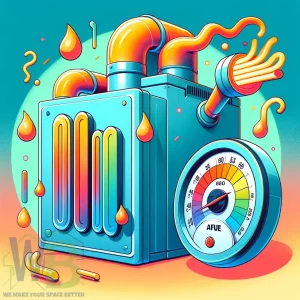What is an Exhaust Ventilation System? – Imagine you’re cooking a big meal, and suddenly, the kitchen fills with smoke and strong odors. Not pleasant, right? That’s where an exhaust ventilation system comes in.
These systems are key to keeping the air in your home fresh and clean.
An exhaust ventilation system removes stale, polluted air inside a building and replaces it with fresh outdoor air. This is crucial for maintaining healthy indoor air quality.
In this article, we’ll explore different types of exhaust systems, how they work, their benefits, and what to consider when choosing one for your home or business. Let’s dive in!

Quick Summary
| Key Takeaways | Details |
|---|---|
| Types of Systems | – Local: Targets specific areas like kitchens. – Whole-House: Removes polluted air from the entire house. |
| Working Principle | – Uses fans to create negative pressure, drawing out stale air. – Involves a balance of air extraction and fresh air intake. |
| Main Components | – Fans: Power the ventilation process. – Ducts: Channel air outside. – Vents: Allow fresh air in. – Controls: Manage system operation. |
| Benefits | – Improves air quality by reducing pollutants. – Enhances comfort by controlling humidity and temperature. – Can be energy-efficient. |
| Choosing a System | – Consider building size, air quality issues, budget, climate. – Local vs. whole-house depends on specific needs. |
| Applications | – Homes: In areas like kitchens, bathrooms. – Commercial: In restaurants, offices, industrial spaces. |
| Maintenance | – Regular filter cleaning/replacement. – Routine inspections and repairs for efficiency and longevity. |
| Conclusion | – Proper ventilation is crucial for health and comfort. – Assess needs, explore options, and consult professionals for the best system selection. |
Understanding the Mechanics
Types of Exhaust Ventilation
There are mainly two types of exhaust ventilation systems:
- Local Exhaust Ventilation: This type targets specific areas in a building, like the kitchen or bathroom. Think of fans and range hoods in your kitchen. They work where you need them, removing smoke and steam from cooking.
- Whole-House Ventilation: This system is more comprehensive. It uses strategically placed fans to remove polluted air from the entire house. It’s like having a team of cleaners working throughout your home to keep the air fresh.
Working Principle
How do these exhaust systems work? They use fans to create negative pressure inside your home. This negative pressure sucks out the stale air.
At the same time, there’s a flow of new, fresh air coming in. This could be passive, like through windows, or intentional, using specific air inlets.
Components of an Exhaust System
What makes up an exhaust ventilation system? Here are the key parts:
- Fans are the system’s heart, powering the ventilation process.
- Ducts: Think of these as highways for air. They carry air from polluted areas to the outside.
- Vents: These are like doors for air. They allow fresh air to enter the building.
- Controls: These are the system’s brains, letting you manage fan speed and operation.
Advantages and Benefits
Improved Indoor Air Quality
A good exhaust ventilation system works wonders for the air you breathe inside your home or office. Here’s how:
- Reduces Pollutants: It lowers levels of CO2, moisture, and annoying cooking fumes.
- Prevents Mold Growth: Reducing moisture stops mold from forming, which is great for your health.
- Minimizes Odors and Airborne Contaminants: Say goodbye to lingering smells and harmful particles in the air!
Enhanced Thermal Comfort
Beyond just clean air, these systems make your space more comfortable:
- Controls Humidity: This helps prevent that sticky feeling and condensation on windows.
- Maintains Cooler Temperatures: It helps keep your home from feeling like an oven, especially in warm climates.
Energy Efficiency Considerations
Thinking about energy bills? Here’s what you need to know:
- Heating and Cooling Costs: The type of system you choose can affect your home’s heating and cooling expenses.
- Energy-Efficient Fans: Look for systems with energy-saving fans to reduce power use.
- Smart Controls: These help manage the system efficiently, saving energy and money.
Considerations and Applications
Choosing the Right Exhaust System
Selecting the best exhaust system for your space involves considering several factors:
- Building Size: Your home or office size can dictate the type of system you need.
- Air Quality Concerns: Consider what air issues you face, like moisture or odors.
- Budget: How much can you spend? This will influence your choices.
- Climate: Your local weather conditions can impact the best system.
Are you deciding between a local or whole-house system? Think about where your air quality issues are most noticeable.
Common Applications
Where are these systems used?
- Homes: Kitchens, bathrooms, laundry rooms, and garages are common spots.
- Commercial Buildings: Good ventilation also greatly benefits restaurants, offices, and industrial settings.
Maintenance and Upkeep
To keep your system running smoothly:
- Filter Cleaning and Replacement: Regularly check and clean or replace filters.
- Regular System Inspection and Repairs: Schedule checks to ensure everything works properly.
Good maintenance keeps your system efficient and extends its life.
Conclusion: What is an Exhaust Ventilation System?
Let’s recap: Exhaust ventilation systems are essential for maintaining healthy indoor air. They remove pollutants, control humidity, and comfort your living or working space.
Whether it’s a local system for specific areas like kitchens and bathrooms or a whole-house system, the right choice can significantly improve the air quality in your home or business.
If you’re considering an exhaust ventilation system:
- Assess Your Needs: Consider your space’s size, air quality issues, and budget.
- Explore Options: Look into different types of systems to find what suits you best.
- Consult Professionals: It’s always a good idea to get expert advice for properly selecting and installing your system.
Remember, investing in a good ventilation system ensures a healthier environment and contributes to the overall well-being and comfort of everyone in the building.







